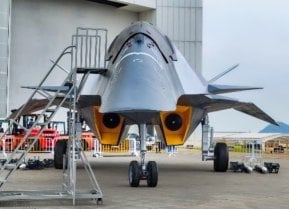The U.S. Navy's Zumwalt-Stealth Destroyer Is Making the Ultimate Comeback
The U.S. Navy plans to test the Conventional Prompt Strike (CPS) hypersonic missile system aboard the USS Zumwalt by 2027 or 2028. The CPS, developed by Lockheed Martin, is a hypersonic boost-glide missile capable of traveling at Mach 5 and delivering precision strikes globally within an hour.
What You Need to Know: The U.S. Navy plans to test the Conventional Prompt Strike (CPS) hypersonic missile system aboard the USS Zumwalt by 2027 or 2028. The CPS, developed by Lockheed Martin, is a hypersonic boost-glide missile capable of traveling at Mach 5 and delivering precision strikes globally within an hour.

-Installation on the Zumwalt requires removing its 155mm Advanced Gun System to make way for four missile-launching tubes, each capable of carrying three CPS missiles. The CPS will also be integrated into Virginia-class submarines, with testing slated for Fiscal Year 2028.
-This effort aims to close the missile capability gap between the U.S. and China.
USS Zumwalt to Test Hypersonic Missiles: A Game-Changer for the Navy
The U.S. Navy has announced intentions to begin testing the Conventional Prompt Strike (CPS) missile system aboard the USS Zumwalt destroyer. The tests are slated to begin in either 2027 or 2028.
Currently, land-based testing of the CPS is still ongoing, which has caused a delay in the installation and testing of the CPS aboard the Zumwalt.
“The testing that we need to do to get to the final integration of Zumwalt, that’s irrespective of where the Zumwalt’s at, whether it’s in the water,” said Vice Admiral Johnny Wolfe, director of strategic programs for the Navy.
Introducing the CPS system
The Conventional Prompt Strike, or CPS, system is, in the words of developer Lockheed Martin, a, “hypersonic boost-glide missile development and test program that provides longer range, shorter flight times, and high survivability against enemy defenses.”

In other words, the CPS is a fast, fast missile. Capable of flying at speeds of about one mile per second, aka Mach five, hypersonic weapons are conventional weapons that promise to greatly augment the capabilities of the user. Specifically, the CPS should allow the Navy to deliver precise weapons, with discriminating accuracy, anywhere in the world, in an hour. That’s a game-changing capability.
To install the CPS on the Zumwalt, the vessel’s existing 155mm Advanced Gun System will need to be removed. As the removal work continues, so does testing on the CPS.
“We’re testing and building the Payload Modular Adapter,” Wolfe said, “aside from what’s going on the actual ship. The missile, the all-up round, we’re continuing forward with all that testing because the missile has to be what we call in-air launched because it’s so large. It’s not like any other type of missile. You don’t light this thing off inside.”
Once installed, the Zumwalt will have four missile-launching tubes; each tube will be able to carry up to three missiles – allowing the Zumwalt to carry twelve hypersonic missiles at a time. Lockheed Martin is building the missile.
The CPS won’t just be limited to the Zumwalt, however. If all goes as planned, the CPS is expected to be installed on the Virginia-class submarine, too. The Virginia installation timeline remains unclear and will depend upon when the Navy receives the Block V Virginia-class. The Navy hopes to test the CPS aboard the Virginia in Fiscal Year 2028.
“The question is going to be when will the first Virginia-class with the Virginia Payload Module be ready to go based on what Admiral Rucker and that team is working to get that system out,” Wolfe said.
The CPS installation, aboard the Zumwalt and the Virginia-class, are effort to mitigate the missile gap between the U.S. and China. Currently, China enjoys an advantage over the U.S. concerning intermediate-range and hypersonic missiles. Being able to deploy multiple hypersonic missiles per Zumwalt or Virginia, should help close the gap.
About the Author: Harrison Kass
Harrison Kass is a defense and national security writer with over 1,000 total pieces on issues involving global affairs. An attorney, pilot, guitarist, and minor pro hockey player, Harrison joined the US Air Force as a Pilot Trainee but was medically discharged. Harrison holds a BA from Lake Forest College, a JD from the University of Oregon, and an MA from New York University. Harrison listens to Dokken.
Image Credit: Creative Commons and/or Shutterstock.


